CAUTION
Always replace disc brake pad assemblies on an axle. Never service one wheel
only.
NOTE: Mazda recommends that new caliper pins be installed whenever
the caliper is removed from the steering knuckle.
CAUTION
Older brake pads may contain asbestos, which has been determined to be a cancer
causing agent. Never clean the brake surfaces with compressed air! Avoid inhaling
any dust from any brake surface! When cleaning brake surfaces, use a commercially
available brake cleaning fluid.
- To avoid fluid overflow when the caliper piston is pressed into the caliper
cylinder bores, remove or siphon part of the brake fluid out of the master
cylinder reservoir (connected to the front disc brakes). Discard the removed
fluid.
- Loosen the wheel lug nuts.
- Raise the vehicle and install jackstands. Remove a front wheel and tire
assembly.
- Place an 8 in. (203mm) C-clamp on the caliper and tighten the clamp slightly
to push the caliper piston in its bore. This will ease caliper removal from
the rotor. Remove the clamp.
NOTE: Do not use a screwdriver or similar tool to pry piston
away from the rotor.
- Remove the upper caliper retaining pin as follows:
- Place one end of a punch, 1⁄2 in.
(13mm) or smaller, against the end of the caliper pin and drive the caliper
pin out of the caliper toward the inside of the vehicle. Do not use a
screwdriver or other edged tool to help drive out the caliper pin as the
V-grooves may be damage.
- Repeat the procedure in Step 4 for the lower caliper pin.
| Fig. 1: Before beginning the brake pad procedure,
remove some fluid from the master cylinder
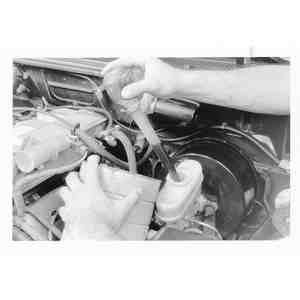
|
| Fig. 2: Use a hammer and punch, and drive the caliper
pin out from between the caliper and its mount
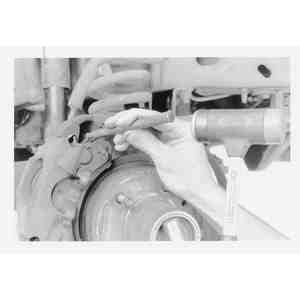
|
| Fig. 3: Pull the out from behind the caliper. Repeat
the procedure for the lower pin
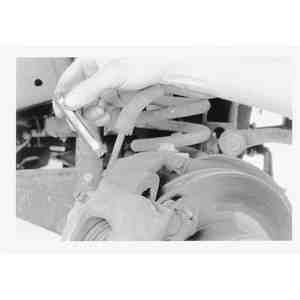
|
- Remove the caliper from the rotor.
- Remove the outer pad. Remove the anti-rattle clips and remove the inner
pad.
- Place the inner pads friction material against the caliper piston and assemble
the C-clamp to the caliper again. Tighten the clamp until the caliper piston
is fully seated into its bore.
| Fig. 4: Slide the caliper assembly off of the rotor
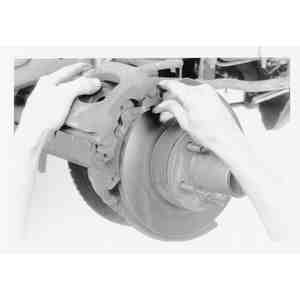
|
| Fig. 5: Holding the caliper as shown, press down
then slide the pad out to remove it from the caliper
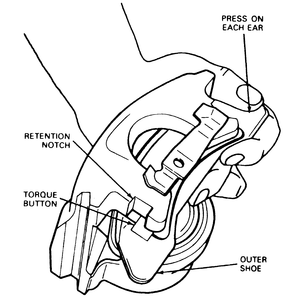
|
| Fig. 6: Remove the outer brake pad from the caliper
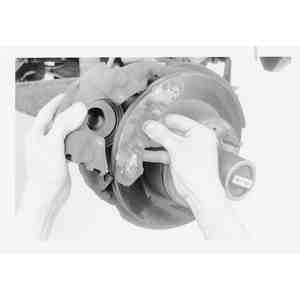
|
| Fig. 7: If necessary, support the caliper by a length
of wire from the frame. Never let it hang by the hose

|
| Fig. 8: Finally, remove the inner brake pad from
the steering knuckle assembly
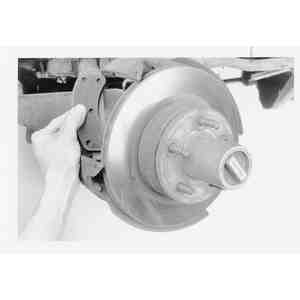
|
| Fig. 9: Place the inner pad's friction material against
the caliper piston and press it in with a C-clamp
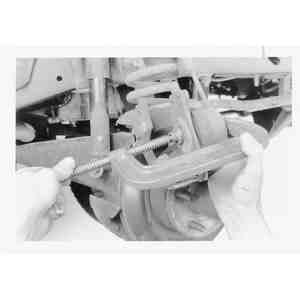
|
| Fig. 10: Ensure that the anti-rattle clip is installed
as shown on the inner pad
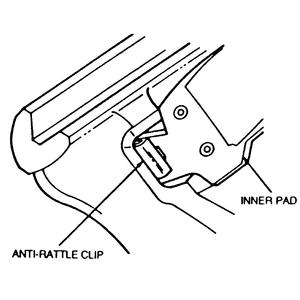
|
| Fig. 11: View of a correctly installed outer pad
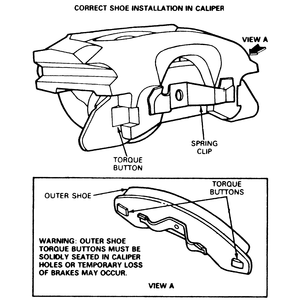
|
| Fig. 12: Ensure that the tang is driven flush to
the caliper mount
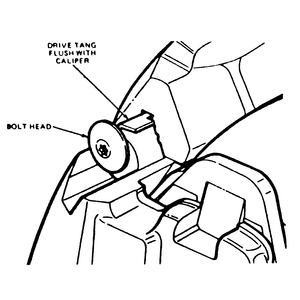
|
| Fig. 13: After installing the pins, ensure that the
tangs are free to contact either side of the caliper mount
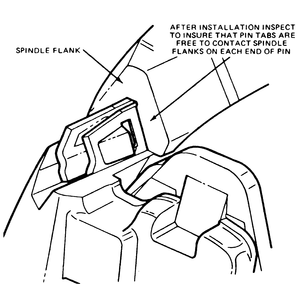
|
To install:
- Place a new anti-rattle clip on the lower end of the inner pad. Be sure
the tabs on the clip are positioned properly and the clip is fully seated.
- Position the inner pads and anti-rattle clip in the abutment with the anti-rattle
clip tab against the pad abutment and the loop-type spring away from the rotor.
Compress the anti-rattle clip and slide the upper end of the pad in position.
- Install the outer pad, making sure the torque buttons on the pad spring
clip are seated solidly in the matching holes in the caliper.
- Install the caliper on the spindle, making sure the mounting surfaces are
free of dirt and lubricate the caliper grooves with Disc Brake Caliper Grease.
Install new caliper pins, making sure the pins are installed with the tang
in position as illustrated. The pin must be installed with the lead tang in
first, the bolt head facing outward (if equipped) and the pin positioned as
shown. Position the lead tang in the V-slot mounting surface and drive in
the caliper until the drive tang is flush with the caliper assembly. Install
the nut (if equipped) and tighten to 32–47 inch lbs.
- Install the wheel and tire assembly.
- Remove the jackstands and lower the vehicle. Torque the lug nuts to 100
ft. lbs. (135 Nm).
NOTE: The first couple of times you apply the brakes, the
pedal may go to the floor. Continue to pump the brake pedal until it feels
firm.
- Check the brake fluid level and fill as necessary. Check the brakes for
proper operation before driving the vehicle.
| Fig. 14: Exploded view of the 4x4 navajo and 1994–97
B Series Pick-up front brake caliper assembly — 4x2 similar
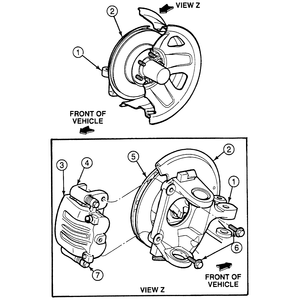
|
| Fig. 15: Exploded view of the 1998 4x4 B Series Pick-up
front brake caliper assembly — 4x2 models similar
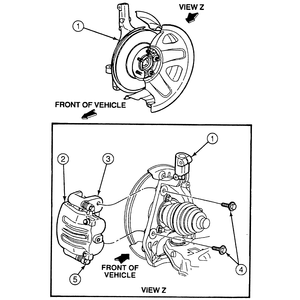
|
| Fig. 16: Use a C-clamp to slightly press in the caliper
piston to aid removal
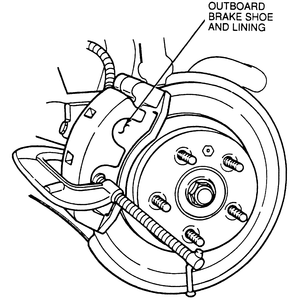
|
CAUTION
Older brake pads or shoes may contain asbestos, which has been determined to
be a cancer causing agent. Never clean the brake surfaces with compressed air!
Avoid inhaling any dust from any brake surface! When cleaning brake surfaces,
use a commercially available brake cleaning fluid.
- To avoid fluid overflow when the caliper piston is pressed into the caliper
cylinder bores, remove or siphon part of the brake fluid out of the master
cylinder reservoir (connected to the front disc brakes). Discard the removed
fluid.
- Loosen the wheel lug nuts.
- Raise and safely support the front of the vehicle. Remove the wheel.
- Place an 8 in. (203mm) C-clamp on the caliper and tighten the clamp to bottom
the caliper pistons in their bores. Remove the clamp.
- Remove the two caliper slide pin bolts and lift the caliper from the anchor
plate.
NOTE: Use care to retain as much of the original caliper
slide pin grease as possible.
- Position the caliper on a frame member or suspend it with some wire. Do
not allow the caliper to hang by the brake hose.
- Remove the brake pads and, if necessary, the anti-rattle clips from the
anchor plate.
- Remove the shims, if any, from the brake pads for re-use.
To install:
- If removed, install the anti-rattle clips.
- Install the brake pads to the anchor plate.
- Position the caliper over the brake pads and align the slide pin mounting
holes.
- Install the slide pin bolts and tighten them to 21–26 ft. lbs. (28–36
Nm).
- Install the wheel and snug the lug nuts.
- Lower the vehicle and tighten the lug nuts to 100 ft. lbs. (135 Nm).
NOTE: The first couple of times you apply the brakes, the
pedal may go to the floor. Continue to pump the brake pedal until it feels
firm.
- Start the engine and apply the brakes several times to readjust the caliper
pistons. Ensure that the pedal feels firm before operating the vehicle.
| Fig. 17: The bottom end of the inner brake pad is equipped
with a pad thickness sensor, which makes a squealing noise to alert you
that the pads must be changed
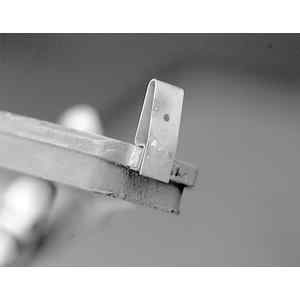
|
| Fig. 18: When removing the disc brake pads, you only
have to remove the bottom caliper slide bolts
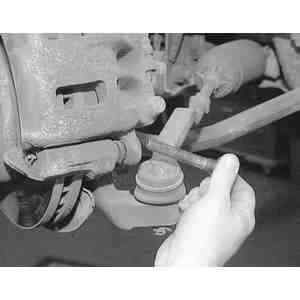
|
| Fig. 19: After removing the bottom sliding bolt, swing
up and support the caliper with a strong piece of wire. Then remove the
inner and outer disc brake pads
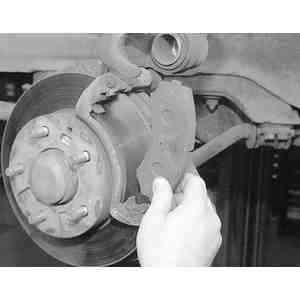
|
| Fig. 20: Using a brake caliper piston and compressor
tool and an old brake pad, push the pistons into the bore. If equipped
with dual piston calipers, it may be necessary to alternate the tool back
and forth between the pistons (arrows)
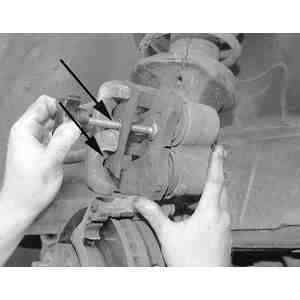
|
| Fig. 21: If necessary, remove and clean, or replace,
the four anti-rattle clips located in the caliper on the ends of each
brake pad
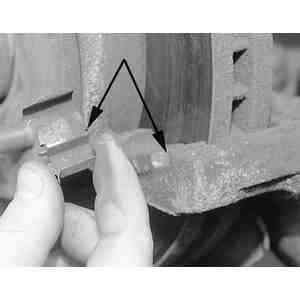
|
| Fig. 22: Before installing the pads and caliper, clean
the anti-rattle clips with a brush
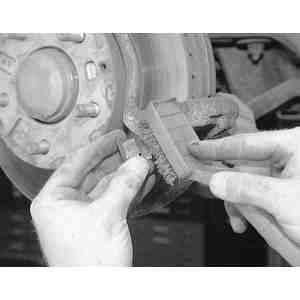
|
| Fig. 23: Before installing the sliding caliper bolts,
clean them and then lubricate them with brake grease
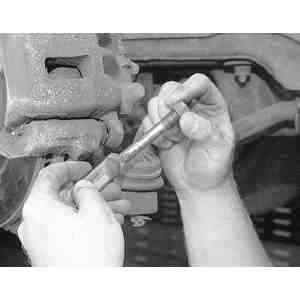
|
- Raise and support the front end on jackstands.
- Remove the wheels.
- Remove the lower lock pin bolt from the caliper.
- Rotate the caliper upward and support the caliper with a strong piece of
wire. Rremove the brake pads, shims, guide plates and if equipped, the springs.
- Remove the master cylinder reservoir cap and remove about half of the fluid
from the reservoir.
- Using a large C-clamp and piece of wood, or a brake caliper piston and compressor
tool and an old brake pad, compress the caliper piston(s) until they bottom
in their bores.
To install:
- Install the shims, guide plates, new pads and if removed, the springs. If
necessary, replace, the four anti-rattle clips located in the caliper on the
ends of each brake pad
- Reposition the caliper and install the lock pin bolt. Tighten the lockbolt
to:
- Front caliper: 62–68 ft. lbs. (84–93 Nm)
- Rear caliper: 28–36 ft. lbs. (38–49 Nm)
- Install the wheels, lower the vehicle, refill the master cylinder and depress
the brake pedal a few times to restore pressure. Bleed the system if required.



